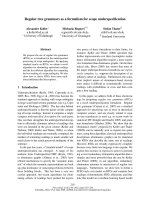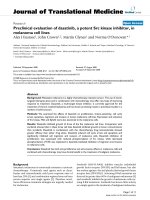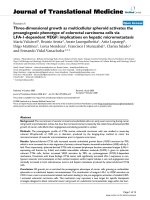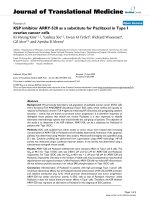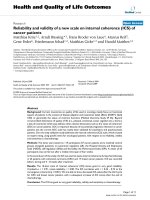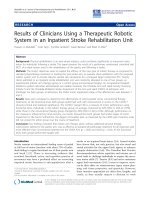báo cáo hóa học:" KSP inhibitor ARRY-520 as a substitute for Paclitaxel in Type I ovarian cancer cells" potx
Bạn đang xem bản rút gọn của tài liệu. Xem và tải ngay bản đầy đủ của tài liệu tại đây (817.15 KB, 9 trang )
BioMed Central
Page 1 of 9
(page number not for citation purposes)
Journal of Translational Medicine
Open Access
Research
KSP inhibitor ARRY-520 as a substitute for Paclitaxel in Type I
ovarian cancer cells
Ki Hyung Kim
†1,2
, Yanhua Xie
†1
, Ewan M Tytler
3
, Richard Woessner
4
,
Gil Mor*
1
and Ayesha B Alvero
1
Address:
1
Department of Obstetrics, Gynecology and Reproductive Sciences, Yale University School of Medicine, New Haven, CT, USA,
2
Department of Obstetrics and Gynecology, Pusan National University, Busan, Korea,
3
Department of Surgery, University of Alabama,
Birmingham, AL, USA and
4
Department of Pharmacology, Array BioPharma, Boulder, CO, USA
Email: Ki Hyung Kim - ; Yanhua Xie - ; Ewan M Tytler - ;
Richard Woessner - ; Gil Mor* - ; Ayesha B Alvero -
* Corresponding author †Equal contributors
Abstract
Background: We previously described a sub-population of epithelial ovarian cancer (EOC) cells
with a functional TLR-4/MyD88/NF-κB pathway (Type I EOC cells), which confers the capacity to
respond to Paclitaxel, a known TLR-4 ligand, by enhancing NF-κB activity and upregulating cytokine
secretion – events that are known to promote tumor progression. It is therefore important to
distinguish those patients that should not receive Paclitaxel; it is also important to identify
alternative chemotherapy options that would benefit this sub-group of patients. The objective of
this study is to determine if the KSP inhibitor, ARRY-520, can be a substitute for Paclitaxel in
patients with Type I EOC.
Methods: EOC cells isolated from either ascites or tumor tissue were treated with increasing
concentrations of ARRY-520 or Paclitaxel and cell viability determined. Activation of the apoptotic
pathway was determined using Western blot analysis. Mitochondrial integrity was quantified using
JC1 dye. Cytokine profiling was performed from supernatants using xMAP technology. NF-κB
activity was measured using a Luciferase reporter system. In vivo activity was determined using a
subcutaneous xenograft mouse model.
Results: ARRY-520 and Paclitaxel exhibited the same cytotoxic effect on Type I and II cells. The
GI
50
at 48 h for Type II EOC cells was 0.0015 μM and 0.2 μM for ARRY-520 and Paclitaxel,
respectively. For Type I EOC cells, the GI
50
at 48 h was > 3 μM and >20 μM for ARRY-520 and
Paclitaxel, respectively. Decrease in the number of viable cells was accompanied by mitochondrial
depolarization and caspase activation. Unlike Paclitaxel, ARRY-520 did not induce NF-κB activation,
did not enhance cytokine secretion, nor induce ERK phosphorylation in Type I EOC cells.
Conclusion: Administration of Paclitaxel to patients with high percentage Type I cancer cells
could have detrimental effects due to Paclitaxel-induced enhancement of NF-κB and ERK activities,
and cytokine production (e.g. IL-6), which promote chemoresistance and tumor progression.
ARRY-520 has similar anti-tumor activity in EOC cells as that of Paclitaxel. However, unlike
Paclitaxel, it does not induce these pro-tumor effects in Type I cells. Therefore, the KSP inhibitor
ARRY-520 may represent an alternative to Paclitaxel in this subgroup of EOC patients.
Published: 20 July 2009
Journal of Translational Medicine 2009, 7:63 doi:10.1186/1479-5876-7-63
Received: 17 April 2009
Accepted: 20 July 2009
This article is available from: />© 2009 Kim et al; licensee BioMed Central Ltd.
This is an Open Access article distributed under the terms of the Creative Commons Attribution License ( />),
which permits unrestricted use, distribution, and reproduction in any medium, provided the original work is properly cited.
Journal of Translational Medicine 2009, 7:63 />Page 2 of 9
(page number not for citation purposes)
Background
Epithelial ovarian cancer (EOC) is the fifth leading cause
of cancer-related deaths in women and is the most lethal
of the gynecologic malignancies [1]. The standard of care
for newly diagnosed EOC patients is surgical debulking
and administration of a platinum and taxane -based
chemotherapy regimen, usually carboplatin and paclit-
axel, given either as neo-adjuvant or adjuvant therapy.
With this regimen, 80–90% will initially respond but less
than 10–15% will remain in complete remission [2,3].
The percentage of non-responders increases significantly
to 65–75% for recurrent cancers[3]. Additionally, some
patients progress during or shortly after completion of
chemotherapy.
Recurrent ovarian cancer is characterized by chemoresist-
ance to prior treatments, most commonly to Paclitaxel.
Previously, we described the identification of a sub-popu-
lation of EOC cells that are resistant to this agent. This
sub-group of cells (Type I EOC cells) has a functional Toll
Like Receptor-4-Myeloid Differentiation Protein 88-
Nuclear factor κB (TLR-4/MyD88/NF-κB) pathway, and
the ligation of TLR-4 by Paclitaxel (a known TLR-4 ligand)
is able to induce NF-κB activation and secretion of pro-
inflammatory and pro-tumor cytokines IL-6, IL-8, MCP-1,
and GRO-α [4,5]. This response confers resistance to
apoptosis, and more importantly, enhances tumor growth
[4]. In contrast, these events were not observed in the
group of EOC cells that did not have a functional TLR4-
MyD88 pathway (Type II EOC cells) and are sensitive to
Paclitaxel.
The treatment of Type I EOC cells with Paclitaxel is not
only ineffective in killing these cells, but more impor-
tantly, can be detrimental since it may enhance tumor
growth. Therefore, the identification of potential new
therapies for this specific cell population would be bene-
ficial for the treatment of ovarian cancer patients.
ARRY-520 is an inhibitor of the mitotic kinesin, KSP. KSP
inhibition prevents bipolar spindle formation leading to
mitotic arrest and cell death [6]. In studies comparing
ARRY-520 with some of the more clinically advanced
compounds and standard of care agents, ARRY-520 was
shown to have superior efficacy in multiple xenograft
models [7] and is currently in a Phase I trial [8]. More
importantly, since KSP is expressed predominantly in pro-
liferating cells and is absent from post-mitotic neurons,
KSP inhibitors do not induce peripheral neuropathy usu-
ally observed with traditional microtubule disrupting
agents such as Paclitaxel [9]. The objective of this study is
two-fold. First, to determine and characterize the anti-
tumor activity of the KSP-inhibitor, ARRY-520, in EOC
cells; and second, to determine whether it is effective
against Type I EOC cells and therefore could be used as a
substitute for Paclitaxel.
We demonstrate that ARRY-520 is able to promote cell
death in EOC cells through an apoptosis mediated mech-
anism, involving caspase-2 activation. More importantly,
we showed that contrary to Paclitaxel, ARRY-520 has no
effect on the TLR4 pathway and does not induce the secre-
tion of pro-inflammatory and pro-tumor cytokines in
Type I EOC cells.
Methods
Cell lines and culture conditions
Established human EOC cell lines, A2780 and A2780/
CP70 (gifts from Dr. TC Hamilton) [10] were propagated
in RPMI plus 10% fetal bovine serum (Gemini Bio-Prod-
ucts, Woodland, CA). Primary EOC cell lines were iso-
lated from malignant ovarian ascites or explanted from
ovarian tumors and cultured as previously described [11-
13]. Use of patient material was approved by Yale Univer-
sity's Human Investigations Committee (HIC # 10425).
Cell viability assay
Cell viability was determined as previously reported [12]
using CellTiter 96
®
AQueous One Solution Cell Prolifera-
tion Assay (Promega Corporation, Madison, WI). ARRY-
520 (Array Biopharma, Boulder, CO) and Paclitaxel
(Sigma Alrich) were added to the medium from a 10 μM
and 3.8 mM stock, respectively to give various final con-
centrations as described in the results section. Each exper-
iment was done in triplicate.
Caspase-3/7, -8, and -9 activity assay
Caspase activity was measured using Caspase-Glo™ 3/7, 8,
or 9 reagents (Promega) as previously described [12].
SDS-PAGE and Western blots
SDS-PAGE and western blots were performed as previ-
ously described [12]. The following antibodies were used:
mouse anti-caspase-2 (BD, 1:1,000), rabbit anti-Bid (Cell
Signaling, Beverly, MA, 1:5,000), mouse anti-XIAP (BD,
1:1,000), mouse anti-phosphorylated ERK (Santa Cruz
Biotechnology, 1:200), and rabbit anti-actin (Sigma,
1:10,000).
Assay of mitochondrial depolarization using JC-1
Cells were trypsinized and stained with JC-1 dye using the
Mitocapture™ mitochondrial apoptosis detection kit (Bio-
Vision Research Products, Mountain View, CA) according
to manufacturer's instructions. Data was acquired using
FACS Calibur System and analyzed using CellQuest soft-
ware (BD Biosciences, San Jose, CA).
Assay for NF-
κ
B activity
NF-κB activity was measured using a luciferase reporter
construct, pBII-LUC, containing two κB sites before a Fos
essential promoter (a gift from Dr. S. Ghosh, Yale Univer-
sity) [5]. Cells were transiently transfected using the
FuGENE 6 Transfection Reagent (Roche Applied Science,
Journal of Translational Medicine 2009, 7:63 />Page 3 of 9
(page number not for citation purposes)
Indianapolis, IN) following the manufacturer's instruc-
tions. Luciferase activity was measured using the Luci-
ferase Assay System (Promega, Madison, WI) according to
the manufacturer's protocol. Briefly, 10 μg of each protein
sample in a total volume of 100 μl was mixed with 20 μl
of the Luciferase Assay Reagent, and luminescence meas-
ured using a TD 20/20 Luminometer (Turner Designs,
Sunnyvale, CA). Relative activity was calculated based on
readings measured from untreated cells after subtracting
blank values. Baseline was set to 100 units. Each sample
was measured in triplicate.
Cytokine profiling
Cytokines were measured from culture supernatants using
the Bio-Plex system (Bio-RAD, Hercules, CA) as previ-
ously described [5,11,14,15].
Mouse xenograft model
The Institutional Animal Care and Use Committee in
Array Biopharma approved all in vivo work. Subcutaneous
tumors were established in female nude mice using
A2780 and a primary culture of EOC cells isolated from
ascites. For each model, mice were randomized into six
groups (n = 8). Group 1: saline (vehicle for ARRY-520);
Group 2: 10% cremophor, 10% ethanol (vehicle for Pacl-
itaxel); Group 3: 20 mg/kg ARRY-520; Group 4: 30 mg/kg
ARRY-520; Group 5: 20 mg/kg Paclitaxel; and Group 6: 30
mg/kg Paclitaxel. Vehicle and compounds were adminis-
tered IP, q4dx3. This treatment schedule was chosen
based on previous anti-tumor and toxicology studies [15-
17]. Tumor size was measured twice a week.
Results
ARRY-520 is cytotoxic in Type II EOC cells
Our first objective was to determine the effect of ARRY-
520 on EOC cells. Thus, two established EOC cell lines
(A2780, CP70) and four EOC cell cultures isolated from
malignant ovarian ascites (R182, 01–28, 01–19b, R1140)
were treated with increasing concentrations of ARRY-520
(up to 3 μM) or Paclitaxel (up to 20 μM) for 24 and 48
hours and cell viability was determined using the CellTiter
96 AQueous One Solution Cell Proliferation Assay. ARRY-
520 effectively decreased cell viability in a time-depend-
ent manner in the Type II EOC cell lines A2780, CP70,
and 01–28 but had minimal effect on Paclitaxel-resistant
Type I EOC cell lines R182, 01–19b, and R1140 (Fig. 1A–
B). In Type II cell lines, the most prominent effect on cell
viability was observed following 48 hours of treatment,
with 50% growth inhibition (GI
50
) observed at 1.5 nM. At
the same time-point, the GI
50
for Type I cells was > 3,000
nM. Interestingly, we saw a similar pattern of response
with equivalent pharmacologic doses of Paclitaxel. As
shown in Table 1, GI
50
was not reached in either com-
pound in Type I EOC cells.
ARRY-520 induces apoptosis in Type II EOC cells
To determine whether the decrease in cell viability is due
to the induction of apoptosis, we measured caspase activ-
ity in ARRY-520-treated Type II EOC cells. Following
ARRY-520 treatment, a significant increase in the activity
of caspases- 8, 9, and 3 was observed in a time-dependent
manner (Fig. 2a), with a corresponding decrease in the
levels of XIAP (Fig. 2b). Moreover, we saw the appearance
of the p30 XIAP fragment at 24 h post-treatment, which
corresponded to the time point where the most significant
increase in caspase-3 activity was observed.
Table 1: In Vitro Response of EOC Cells
Cell line GI
50
for
ARRY-520, μM
GI
50
for
Paclitaxel, μM
A2780 0.0015 0.2
CP70 0.0015 0.2
01–28 0.0015 0.2
R182 >3 >20
01–19b >3 >20
R1140 >3 >20
ARRY-520 significantly decreases the number of viable Type II EOC cellsFigure 1
ARRY-520 significantly decreases the number of via-
ble Type II EOC cells. The viability (in percentage, normal-
ized to untreated cells) of EOC cells after treatment with
increasing concentrations of ARRY-520 for (a) 24 and (b) 48
hours. Data were compiled from at least three independent
experiments, each done in triplicate. Type I cells – R182, 01–
19b, R1140; Type II cells – A2780, CP70, 01–28; dotted line
corresponds to 50% viability.
Journal of Translational Medicine 2009, 7:63 />Page 4 of 9
(page number not for citation purposes)
ARRY-520-induced apoptosis involves the activation of
Caspase-2 but not the mitochondrial pathway
Our next objective was to determine the upstream signals
involved in ARRY-520-induced apoptosis. Caspase-2 is a
more recently described initiator caspase required in
stress-induced apoptosis [18]. Thus, we determined cas-
pase-2 activation in ARRY-520-treated Type II EOC cells
using western blot analysis. Our results showed that
ARRY-520 is able to induce caspase-2 activation in a time-
dependent manner similar to that observed with the other
caspases-9, -8, and -3 (Fig. 2b).
Previous studies showed that caspase-2 could initiate
apoptosis via three mechanisms. First, by direct action on
mitochondrial membranes [19], second, by inducing
mitochondrial depolarization through Bid [20], and
third, by direct activation on effector caspases [21]. To fur-
ther characterize ARRY-520-induced apoptosis, we next
determined which of these pathways occur downstream
of caspase-2. Western blot analysis of whole cell lysates
showed that full-length Bid is maintained (Fig. 2b) and
therefore is not activated. Furthermore, analysis of mito-
chondrial integrity showed that the mitochondria remain
intact in ARRY-520-treated cells (Fig. 3a and 3b). These
results suggest that ARRY-520-induced caspase-2 activa-
tion leads to the direct activation of effector caspases with-
out the involvement of the mitochondria.
ARRY-520 does not induce NF-
κ
B activation and cytokine
secretion in Type I EOC cells
ARRY-520 and Paclitaxel are both antimitotic agents but
target different components of the mitosis machinery.
Whereas Paclitaxel targets the microtubules directly,
ARRY-520 targets the kinesin spindle protein.
Recently, we reported that Paclitaxel, which is a known
TLR-4 ligand, is able to activate NF-κB and induce the
secretion of pro-inflammatory cytokines and chemokines
in Type I EOC cells [4,5]. Thus, our next objective was to
determine the effect of ARRY-520 on NF-κB and cytokine
profile in this sub-group of EOC cells. As shown in Fig. 4,
unlike Paclitaxel, ARRY-520 at the highest dose used (3
μM) does not induce NF-κB activation. In addition, ARRY-
520 does not increase the secretion of pro-tumor
cytokines IL-6, IL-8, and GRO-α (Fig. 5), which was previ-
ously seen with Paclitaxel treatment. Instead, ARRY-520 is
able to down-regulate the constitutive MCP-1 secretion in
these cells.
ARRY-520 does not induce ERK1/2 phosphorylation in
Type I EOC cells
The extracellular signal-regulated kinase (ERK) pathway is
involved in the regulation of cell proliferation, cell differ-
entiation, and cell survival [22]. Physiological doses of
Paclitaxel have been previously shown to induce a sus-
tained phosphorylation of ERK 1/2 in human esophageal
squamous cancer cells [23]. This is probably a compensa-
tory survival response by the cancer cells to the drug treat-
ment. Therefore, we evaluated the differential effect of
Paclitaxel and ARRY-520 on the phosphorylation status of
ERK 1/2 in Type I EOC cells. Paclitaxel, but not ARRY-520,
induced the phosphorylation of ERK 1/2 (Fig. 6). Taken
together, these results suggest that in Type I EOC cells and
within the context of decreased cell viability, Paclitaxel is
able to activate pro-survival pathways, which may lead to
compensatory proliferation in the remaining viable cells.
The activation of these pro-survival pathways was how-
ever, not observed with ARRY-520 treatment.
ARRY-520 has comparable in vivo activity to Paclitaxel
Our final objective was to determine the activity of ARRY-
520 in an EOC mice xenograft model. Thus, we estab-
lished a subcutaneous (s.c.) model in nude mice using
A2780, an established EOC cell line, and R182, a primary
culture isolated from patient's ascites (Type II and Type I,
respectively). The anti-tumor activitiy of ARRY-520 and
Paclitaxel was then determined as described in the Meth-
ods section. In this animal model, the results confirmed
our in vitro observation that the compounds demonstrate
ARRY-520 induces apoptosis in Type II EOC cellsFigure 2
ARRY-520 induces apoptosis in Type II EOC cells.
Type II EOC cells were treated with 3 μM ARRY-520 for 6,
12, and 24 hours. "0" designation represents non-treated
controls. (a) Activity of capase-3, -8, and -9 was measured
using Caspase-Glo assay, and (b) effect on XIAP, Caspase-2,
and Bid was determined using Western blot analysis. Results
shown are for CP70. Similar results were observed with
other cells tested.
Journal of Translational Medicine 2009, 7:63 />Page 5 of 9
(page number not for citation purposes)
equivalent activity against ovarian cancer cells. Both com-
pounds induced a decrease in tumor kinetics in a dose-
dependent manner (Fig. 7a and 7b).
Discussion
We demonstrate in this study that the KSP inhibitor,
ARRY-520, has similar anti-tumor activity in EOC cells
compared to Paclitaxel. More importantly though, unlike
Paclitaxel, ARRY-520 does not activate NF-κB and does
not induce secretion of pro-tumor cytokines in Type I
EOC cells. Therefore, ARRY-520 may represent an alterna-
tive to Paclitaxel in this subgroup of EOC cells.
KSP is a microtubule-associated motor protein, which is
essential for centrosome separation, formation of a bipo-
lar mitotic spindle, and proper segregation of sister chro-
matids during mitosis [24]. Inhibition of KSP forms
monopolar mitotic spindles and arrests cells at mitosis,
which leads to cell death [25,26]. KSP inhibitors have
been shown to exhibit antitumor activity and are currently
in clinical trials [7,9]. Because KSP localizes to mitotic
microtubules, KSP inhibitors function exclusively during
ARRY-520 induces apoptosis independent of the mitochondrial pathwayFigure 3
ARRY-520 induces apoptosis independent of the mitochondrial pathway. (a) Type II EOC cells were treated with 3
μM ARRY-520 for 12 and 24 hours, stained with JC-1 dye as described in the Materials and Methods section, and mitochondrial
integrity was analyzed using Flow cytometry. (b) Graphical representation of the percentage of polarized and depolarized cells.
Note that ARRY-520 does not induce mitochondrial depolarization. Results shown are obtained with CP70 cells. Similar
results were observed with other cells tested.
Differential effect of ARRY-520 and Paclitaxel on NF-κB acti-vation in Type I EOC cellsFigure 4
Differential effect of ARRY-520 and Paclitaxel on NF-
κB activation in Type I EOC cells. Cells were trans-
fected with a luciferase reporter plasmid activated by NF-κB
and treated with either 3 μM ARRY-520 or 2 μM Paclitaxel.
NF-κB activity was measured as luminescence. Data shown
are for R182 cells. Similar results were obtained with other
Type I EOC cells tested.
Journal of Translational Medicine 2009, 7:63 />Page 6 of 9
(page number not for citation purposes)
Differential effect of ARRY-520 and Paclitaxel on cytokine profile in Type I EOC cellsFigure 5
Differential effect of ARRY-520 and Paclitaxel on cytokine profile in Type I EOC cells. Cells were treated with
ARRY-520 (0.03, 0.3, 3 μM) or Paclitaxel for (0.2, 2, 20 μM) for 48 hrs and levels of secreted cytokines/chemokines were
determined using xMAP technology.
Differential effect of ARRY-520 and Paclitaxel on ERK activation in Type I EOC cellsFigure 6
Differential effect of ARRY-520 and Paclitaxel on ERK activation in Type I EOC cells. Cells were treated with
ARRY-520 (0.03, 0.3, 3 μM) or Paclitaxel for (0.2, 2, 20 μM) for 24 hrs and levels of phospho-ERK (p-ERK) and total ERK (t-
ERK) weredetermined by Western blotting.
Journal of Translational Medicine 2009, 7:63 />Page 7 of 9
(page number not for citation purposes)
mitosis and are therefore selective to mitotic cells. Indeed,
KSP inhibitors are shown to spare post mitotic neurons
and thus do not cause peripheral neuropathy, which is a
major side effect observed in Paclitaxel treatment [9]. In
the present study, we showed an additional advantage for
the use of the KSP inhibitor ARRY-520 over Paclitaxel,
specifically in Type I EOC cells.
In the subgroup of EOC cells with a functional TLR-4/
MyD88/NF-κB pathway, Paclitaxel treatment leads to pro-
liferation and NF-κB activation [4,14]. The activation of
NF-κB is a major component in cancer initiation and pro-
gression [27] and plays a central role in the control of
apoptosis, cell proliferation, and survival [28,29]. Animal
models have further supported the link between NF-κB
activation and cancer progression [30]. The demonstra-
tion that Paclitaxel can bind to TLR4 [31] and therefore
activate NFκB could explain why we observe tumor
growth during Paclitaxel treatment [4]. The absence of
NFκB activation after ARRY-520 treatment suggests that
ARRY-520 may be a better treatment option in patient
with Type I EOC cells.
Another important aspect associated with NF-κB activa-
tion is the potential effect on the immune system. We
showed previously that in Type I EOC cells, Paclitaxel
treatment is able to induce the secretion of the pro-
inflammatory cytokines IL-6, IL-8, MCP-1, and GROα
[5,14]. All of these cytokines have been shown to directly
affect cancer cell survival and growth [32,33] and also
have implications in the resulting immune response.
Indeed, our group has shown that the secretion of these
cytokines by the Type I EOC cells is able to modulate the
type of cytokines produced by the monocyte-like THP-1
cell line [34]
It was noted that the mice with xenografts obtained from
either the Type I or Type II cell lines responded equally to
both compounds. These results did not reflect those seen
in vitro where Type I EOC cells are more resistant to treat-
ment. Our group recently reported the identification and
characterization of the ovarian cancer stem cells using the
cell surface marker, CD44 [14]. In this report, we showed
that CD44+ cells represent the specific cell population
that has a functional TLR-4/MyD88/NF-κB pathway.
In vivo activity of ARRY-520 and PaclitaxelFigure 7
In vivo activity of ARRY-520 and Paclitaxel. EOC tumors were established s.c. in female nude mice and treatments were
given as described in the Materials and Methods section. Tumor size was determined by caliper measurements. (a) A2780
xenograft model and (b) tumors established from a primary culture of EOC cells.
Journal of Translational Medicine 2009, 7:63 />Page 8 of 9
(page number not for citation purposes)
Indeed injection of R182 cells in mice (which is > 90%
CD44+ by flow cytometry pre-injection) resulted in s.c.
tumors containing < 10% CD44+ positive cells [14]. The
differentiation of the R182 cells from Type I to Type II in
vivo may explain the equivalent chemoresponse observed
from the two xenograft models.
It is important to emphasize that this response induced by
Paclitaxel is not observed in all EOC cells, but is limited to
a specific sub-group, the Type I EOC cells.
In summary, ARRY-520 may represent an alternative to
Paclitaxel in Type I EOC cells. This suggests the impor-
tance of identifying the molecular phenotype of the tumor
prior to the initiation of therapy.
Conclusion
Administration of Paclitaxel to patients with high percent-
age Type I cancer cells could have detrimental effects due
to Paclitaxel-induced enhancement of NF-κB and ERK
activities and cytokine production (e.g. IL-6), which pro-
mote chemoresistance and tumor progression. ARRY-520
has similar anti-tumor activity in EOC cells as that of Pacl-
itaxel. However, unlike Paclitaxel, it does not induce these
pro-tumor effects in Type I cells. Therefore, the KSP inhib-
itor ARRY-520 may represent an alternative to Paclitaxel
in this subgroup of EOC patients.
Abbreviations
EOC: epithelial ovarian cancer cell; KSP: kinesin spindle
protein; NF-κB: nuclear factor κB; XIAP: X-linked inhibi-
tor of apoptosis protein; JC-1: 5,5',6,6'-tetrachloro-
1,1',3,3'-tetraethyl-benzamidazolocarbocyanin iodide
Competing interests
KK, YX, ET, GM, and AA do not have competing interests.
RW is an employee of Array Biopharma.
Authors' contributions
KK and YX performed cell viability assays, western blots,
and luciferase assays. ET performed the mitochondrial
depolarization assay. RW performed the in vivo experi-
ments. GM participated in the design of the study and
helped to draft the manuscript. AA participated in the
design, analysis, and coordination of the study and the
final drafting of the manuscript. All authors have read and
approved the final manuscript.
Acknowledgements
This work was supported in part by NCI RO1CA118678. The KSP inhibitor
ARRY-520 was provided by Array Biopharma, Boulder, CO. The authors
would like to thank Ms. Paulomi Aldo and Ms. Irene Visintin for assistance
in the experiments involving the xMAP technology, Ms. Jamie Green for
editing and proofreading the manuscript, and the UAB Arthritis and Musc-
uloskeletal Center flow cytometry core facility for providing the instrumen-
tation for FACS analysis.
References
1. Schwartz PE: Current diagnosis and treatment modalities for
ovarian cancer. Cancer Treat Res 2002, 107:99-118.
2. Berchuck A, Elbendary A, Havrilesky L, Rodriguez GC, Bast RC Jr:
Pathogenesis of ovarian cancers. J Soc Gynecol Investig 1994,
1:181-190.
3. Mutch DG: Surgical management of ovarian cancer. Semin
Oncol 2002, 29:3-8.
4. Kelly MG, Alvero AB, Chen R, Silasi DA, Abrahams VM, Chan S, Vis-
intin I, Rutherford T, Mor G: TLR-4 signaling promotes tumor
growth and paclitaxel chemoresistance in ovarian cancer.
Cancer Res 2006, 66:3859-3868.
5. Chen R, Alvero AB, Silasi DA, Kelly MG, Fest S, Visintin I, Leiser A,
Schwartz PE, Rutherford T, Mor G: Regulation of IKKbeta by
miR-199a affects NF-kappaB activity in ovarian cancer cells.
Oncogene 2008, 27:4712-4723.
6. Vijapurkar U, Wang W, Herbst R: Potentiation of kinesin spindle
protein inhibitor-induced cell death by modulation of mito-
chondrial and death receptor apoptotic pathways. Cancer Res
2007, 67:237-245.
7. Woessner R, Corrette C, Allen S, Hans J, Aicher T, Lyssikatos J, Rob-
inson J, Poch G, Hayter L, Cox A, Lee P, Winkler J, Koch K, Wallace
E: ARRY-520, a KSP inhibitor with efficacy and pharmacody-
namic activity in animal models of solid tumor. 2007 American
Association for Cancer Research Annual Meeting; Los Angeles, CA 2007.
8. Bayes M, Rabasseda X, Prous JR: Gateways to clinical trials. Meth-
ods Find Exp Clin Pharmacol 2007, 29:625-655.
9. Zhang Y, Xu W: Progress on kinesin spindle protein inhibitors
as anti-cancer agents. Anticancer Agents Med Chem 2008,
8:698-704.
10. Behrens BC, Hamilton TC, Masuda H, Grotzinger KR, Whang-Peng J,
Louie KG, Knutsen T, McKoy WM, Young RC, Ozols RF: Charac-
terization of a cis-diamminedichloroplatinum(II)-resistant
human ovarian cancer cell line and its use in evaluation of
platinum analogues. Cancer Res 1987, 47:414-418.
11. Alvero AB, Chen R, Fu HH, Montagna M, Schwartz PE, Rutherford T,
Silasi DA, Steffensen KD, Waldstrom M, Visintin I, Mor G: Molecular
phenotyping of human ovarian cancer stem cells unravels
the mechanisms for repair and chemoresistance. Cell Cycle
2009,
8:158-166.
12. Alvero AB, O'Malley D, Brown D, Kelly G, Garg M, Chen W, Ruther-
ford T, Mor G: Molecular mechanism of phenoxodiol-induced
apoptosis in ovarian carcinoma cells. Cancer 2006,
106:599-608.
13. Kamsteeg M, Rutherford T, Sapi E, Hanczaruk B, Shahabi S, Flick M,
Brown D, Mor G: Phenoxodiol – an isoflavone analog – induces
apoptosis in chemoresistant ovarian cancer cells. Oncogene
2003, 22:2611-2620.
14. Alvero AB, Chen R, Fu H, Montagna M, Schwartz PE, Rutherford T,
Silasi D, Steffensen KD, Visintin I, Mor G: Molecular phenotyping
of human ovarian cancer stem cells unravel the mechanisms
for repair and chemo-resistance. Cell Cycle 2008, 8:158-166.
15. Alvero AB, Montagna MK, Chen R, Kim KH, Kyungjin K, Visintin I, Fu
HH, Brown D, Mor G: NV-128, a novel isoflavone derivative,
induces caspase-independent cell death through the Akt/
mammalian target of rapamycin pathway. Cancer 2009 in
press.
16. Woessner R, Cox A, Koch K, Lee P, Sumeet R, Tunquist B, Walker
D, Winkler J: In vivo and pharmacodynamic profiling of the
KSP inhibitor ARRY-520 supports potent activity in hemato-
logical cancers and drug resistant tumors. Proc Am Assoc Cancer
Res 2009, 50:4703.
17. Woessner R, Corrette C, Allen S, Hans J, Aicher T, Lyssikatos J, Rob-
inson J, Poch G, Hayter L, Cox A, Lee P, Winkler J, Koch K, Wallace
E: ARRY-520, a KSP inhibitor with efficacy and pharmacody-
namic activity in animal models of solid tumors. Proc Am Assoc
Cancer Res 2007, 48:1433.
18. Lassus P, Opitz-Araya X, Lazebnik Y: Requirement for caspase-2
in stress-induced apoptosis before mitochondrial permeabi-
lization. Science 2002, 297:1352-1354.
19. Guo Y, Srinivasula SM, Druilhe A, Fernandes-Alnemri T, Alnemri ES:
Caspase-2 induces apoptosis by releasing proapoptotic pro-
teins from mitochondria. J Biol Chem 2002, 277:13430-13437.
20. Wagner KW, Engels IH, Deveraux QL: Caspase-2 can function
upstream of bid cleavage in the TRAIL apoptosis pathway. J
Biol Chem 2004, 279:35047-35052.
Publish with Bio Med Central and every
scientist can read your work free of charge
"BioMed Central will be the most significant development for
disseminating the results of biomedical research in our lifetime."
Sir Paul Nurse, Cancer Research UK
Your research papers will be:
available free of charge to the entire biomedical community
peer reviewed and published immediately upon acceptance
cited in PubMed and archived on PubMed Central
yours — you keep the copyright
Submit your manuscript here:
/>BioMedcentral
Journal of Translational Medicine 2009, 7:63 />Page 9 of 9
(page number not for citation purposes)
21. Shin S, Lee Y, Kim W, Ko H, Choi H, Kim K: Caspase-2 primes
cancer cells for TRAIL-mediated apoptosis by processing
procaspase-8. EMBO J 2005, 24:3532-3542.
22. Lewis TS, Shapiro PS, Ahn NG: Signal transduction through MAP
kinase cascades. Adv Cancer Res 1998, 74:49-139.
23. Okano J, Rustgi AK: Paclitaxel induces prolonged activation of
the Ras/MEK/ERK pathway independently of activating the
programmed cell death machinery. J Biol Chem 2001,
276:19555-19564.
24. Blangy A, Lane HA, d'Herin P, Harper M, Kress M, Nigg EA: Phos-
phorylation by p34cdc2 regulates spindle association of
human Eg5, a kinesin-related motor essential for bipolar
spindle formation in vivo. Cell 1995, 83:1159-1169.
25. Sakowicz R, Finer JT, Beraud C, Crompton A, Lewis E, Fritsch A, Lee
Y, Mak J, Moody R, Turincio R, Chabala JC, Gonzales P, Roth S, Weit-
man S, Wood KW: Antitumor activity of a kinesin inhibitor.
Cancer Res 2004, 64:3276-3280.
26. Tao W, South VJ, Diehl RE, Davide JP, Sepp-Lorenzino L, Fraley ME,
Arrington KL, Lobell RB: An inhibitor of the kinesin spindle pro-
tein activates the intrinsic apoptotic pathway independently
of p53 and de novo protein synthesis. Mol Cell Biol 2007,
27:689-698.
27. Pikarsky E, Porat RM, Stein I, Abramovitch R, Amit S, Kasem S, Gutk-
ovich-Pyest E, Urieli-Shoval S, Galun E, Ben-Neriah Y: NF-kappaB
functions as a tumour promoter in inflammation-associated
cancer. Nature 2004, 431:461-466.
28. Rothwarf DM, Karin M: The NF-kappa B activation pathway: a
paradigm in information transfer from membrane to
nucleus. Sci STKE 1999, 1999:RE1.
29. Vainer GW, Pikarsky E, Ben-Neriah Y: Contradictory functions of
NF-kappaB in liver physiology and cancer. Cancer Lett 2008,
267:182-188.
30. Greten FR, Karin M: The IKK/NF-kappaB activation pathway-a
target for prevention and treatment of cancer. Cancer Lett
2004, 206:193-199.
31. Byrd-Leifer CA, Block EF, Takeda K, Akira S, Ding A: The role of
MyD88 and TLR4 in the LPS-mimetic activity of Taxol. Eur J
Immunol 2001,
31:2448-2457.
32. Lazar-Molnar E, Hegyesi H, Toth S, Falus A: Autocrine and para-
crine regulation by cytokines and growth factors in
melanoma. Cytokine 2000, 12:547-554.
33. Nicolini A, Carpi A, Rossi G: Cytokines in breast cancer. Cytokine
Growth Factor Rev 2006, 17:325-337.
34. Alvero AB, Aldo P, Mor G: MyD88-positive ovarian cancer cells
regulate monocyte migration and differentiation. Annual
Meeting of American Society for Reproductive Immunology; Nashville, TN
2006.
